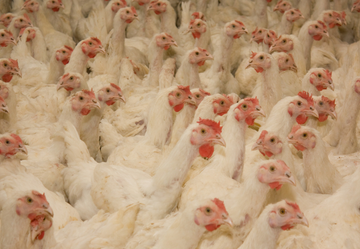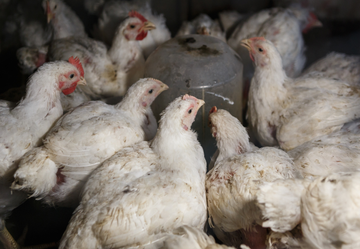Why the Better Chicken Commitment
Consumers are demanding improved animal welfare and food quality standards.

Consumer Demand
Studies show that consumers are increasingly concerned about where their food comes from. In 2015, a survey by Mintel found that 74% of UK consumers thought sourcing meat from animals that are well looked after is among the top criteria that makes a food company ethical and half (52%) of consumers say they would stop buying products from a company if they found out it was acting unethically.

Quality Problems
In the UK and across Europe white breast meat is favoured over the darker meat from the rest of the body and the strong consumer demand for white meat drove the chicken industry to breed a chicken that would grow as quickly, and as large, as possible to deliver as much white meat as possible.
This accelerated growth has resulted in product quality issues affecting the chicken market, namely the widespread issues of muscular myopathies such as woody breast and white striping. Woody breast causes the meat to be tough and difficult to chew, while white striping is a visible condition in which fat and collagen congeal in white stripes across the outside of chicken breasts. These abnormalities are strongly linked to accelerated weight gain and rapid breast muscle growth in the most popular broiler breeds.
The introduction of higher-welfare breeds could significantly reduce meat quality abnormalities.
Animal Welfare
Over 99 percent of chickens raised for the UK and European market are kept in conditions in which the following factors contribute to serious health and welfare issues:
Breed
The modern chicken has been selectively bred and commercialized over many decades, prioritizing fast growth and large breast muscles over any consideration for welfare. Chickens now grow so big, so quickly, their bodies can’t keep up. Their legs can’t cope with the weight of their upper bodies[1], so they suffer from leg pain and lameness. Their hearts and other organs are under pressure, and many die prematurely from heart disease.

Stocking Density
Numerous studies have linked the problems of movement and ammonia burns to stocking density[2]. When chickens are crammed so tightly together, the litter becomes soiled more quickly, and mobility is decreased because birds have inadequate room to move.

Housing
As standard industry practice, chickens are forced to live in a completely barren environment with wet, dirty litter. Many are subjected to near-constant, low-intensity artificial lighting with short periods of continuous darkness and virtually no stimulating resources. So many chickens with so little space per bird means that they live right on top of their own waste. This ongoing contact with the ammonia-laden litter can cause foot pad dermatitis (lesions on the bottom of their feet), breast blisters, and hock burns (ammonia burns through the skin). These conditions all result in extremely poor welfare.

Slaughter
The most prevalent slaughter method in the United States poultry industry is live-shackling, a system by which birds are hung upside down by their feet in metal shackles.[3] An electrified water bath is meant to give them a shock that renders them unconscious; however, many are not effectively stunned and continue in the process while conscious. Some may then still be conscious at the point of having their throats cut, and a small but not insignificant percentage are alive long enough to experience the boiling water that is used to remove their feathers.
For more information on these animal welfare concerns, please see the EU Broiler Chicken Welfare White Paper.
Lilburn, M. S. Skeletal growth of commercial poultry species. Poult. Sci. 73, 897–903 (1994). ↩︎
Haslam, S. M. et al. Factors affecting the prevalence of foot pad dermatitis, hock burn and breast burn in broiler chicken. Br. Poult. Sci. 48, 264–275 (2007) ↩︎
Shields, S. J. & Raj, A. B. M. A critical review of electrical water-bath stun systems for poultry slaughter and recent developments in alternative technologies. J. Appl. Anim. Welf. Sci. 13, 281–299 (2010). ↩︎
